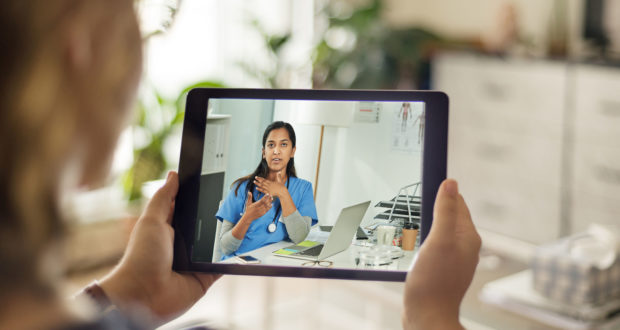The Aged Care Royal Commission report offers a glimmer of hope into fixing our aged care system, with the Government committing almost half a billion dollars in an immediate response to the 148 recommendations.
While a large part of the report focuses on the quality of care and support delivered by nurses and carers that have physical contact with older people, several recommendations aim to improve the quality of medical care through telehealth. Recommendation 63 asks for access to specialist telehealth service, it’s evident the Government is now taking this matter seriously and finally listening to older people, their families and workers.
A step in the right direction
The summary of the report states that “telehealth is a means of avoiding the potential harm and distress for frail older people caused by travel to receive medical care”. This recognises that older people, no matter where they live, are finding it difficult to access medical care without travelling and this simple act can in and of itself cause harm.
While subsidised specialist telehealth services are currently available to people living in residential aged care, they’re not to those who access aged care from their homes, unless they live in remote Australia or access an Aboriginal Medical Service, impacting access for lots of Australians.
Recommendation 63 addresses this point, and requires the Australian Government to expand access to Medicare Benefits Schedule-funded specialist telehealth services to older people receiving personal care at home, and requires aged care providers delivering care to have the necessary equipment as well as clinically and culturally capable staff to support telehealth services by 1 November 2021.
This is an important step in the right direction because many older people have trouble travelling to receive medical care - regardless of where they live, in their own home or a facility. There are even cases of elderly patients dying on their trip to a checkup or rehab, tripping or falling, being in an accident or having a mental or physical breakdown. And specialists like oncologists, cardiologists and neurologists rarely make house calls so travel tends to be a requirement to access this care.
As well as this, requiring aged care providers to make available the necessary equipment and staff to receive telehealth is a positive step towards future-proofing the healthcare sector through digital transformation.
Limited to medical specialists
However, one of the most concerning gaps in this recommendation is limiting it to medical specialists only. Throughout the pandemic, we’ve seen the widespread adoption of telehealth by GPs and allied health practitioners, who have been able to successfully deliver their services via video telehealth. Last year, a total of 43 million telehealth consultations took place across Australia, with many millions of these keeping our elders safe by reducing the risk of exposure and potential infection from in-person consultations.
Limiting this recommendation to specialists only is missing a trick.
Surely, the delivery of GP and allied health services via telehealth is just as important in reducing exposure to harm as is specialist consultations. In fact, video telehealth for these primary care services may even lead to more timely access to care as often, older people can struggle to find a carer to take them to the GP, the physiotherapist, the dietitian, the dentist or the psychologist.
We’re thinking too slow
Another area that is lacking is the overhaul of the primary care model. Recommendation 56 refers to telehealth as part of the new primary care model that the government is suggested to trail for six to ten years. However, the pandemic has given us more than enough data to confirm that telehealth as a primary care strategy works for providing timely, clinically adequate and outcome-oriented care.
Throughout the pandemic, telehealth has proven its value to the industry, consumers and healthcare practitioners alike -- with a whopping 97 per cent of Aussie GPs now using telehealth to provide healthcare services, compared to just 15 per cent before the pandemic. We simply can’t wait another decade to make video telehealth standard practise for delivering healthcare to our elders, who are some of our most vulnerable Australians.
Video telehealth directly addresses existing issues around a lack of timely access to GPs and allied health practitioners when and where needed as well as for those with reduced mobility, while addressing language barriers and geographic limitations. Telehealth also plays a key role in supporting the mental health of patients. Running this experiment for up to another decade is simply thinking too slow.
In a bid to expand access to subsidised telehealth services and ensure providers have the necessary equipment and capable staff to support it, telehealth must be holistically integrated into the aged care system and this is something which is missing from the recommendations.
If video telehealth is integrated comprehensively, we’ll have the ability to enhance healthcare delivery and outcomes for older Australians, upskill and reduce time and work pressures on residential aged care workers, and enable more clinicians to service more of our ageing population. The implementation of funding arrangements to offset costs for patients would further bolster the system and alleviate the financial pressure felt by many senior Australians and pensioners.
The future of healthcare truly is a hybrid approach where patients can choose between in-person or virtual care options according to their needs and preferences. And while physical consultations are still vital, video telehealth can play a key role in helping make healthcare more accessible to older communities and directly impact how we access healthcare in the future. While the Aged Care Commission recommendations are a step in the right direction, we need to start thinking outside the box as we plan for our digital future, and ultimately, protect an ageing population.
Dr Silvia Pfeiffer, is CEO and co-founder of Coviu
Do you have an idea for a story?Email [email protected]
 Aged Care Insite Australia's number one aged care news source
Aged Care Insite Australia's number one aged care news source

